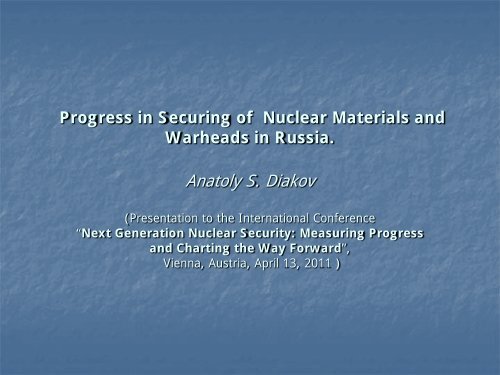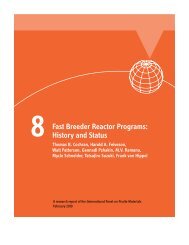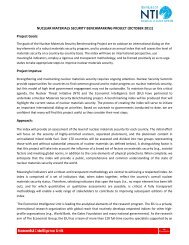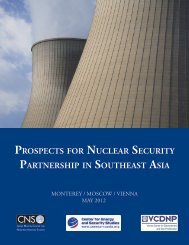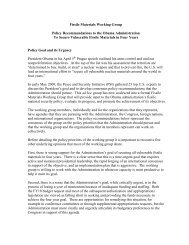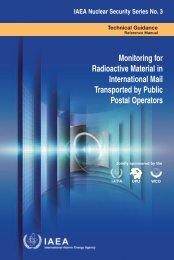Anatoly Diakov - Fissile Materials Working Group
Anatoly Diakov - Fissile Materials Working Group
Anatoly Diakov - Fissile Materials Working Group
- No tags were found...
Create successful ePaper yourself
Turn your PDF publications into a flip-book with our unique Google optimized e-Paper software.
Progress in Securing of Nuclear <strong>Materials</strong> andWarheads in Russia.<strong>Anatoly</strong> S. <strong>Diakov</strong>(Presentation to the International Conference“Next Generation Nuclear Security: Measuring Progressand Charting the Way Forward”,Vienna, Austria, April 13, 2011 )
In September 2009, President of the RF Medvedev declared that one ofthe most dangerous threat to the national and world security isacquiring of nuclear components by terrorists. He stated that thecurrent security system in this sphere requires modernization andworld community should think how to make this system is modernand effective.What Russia’s priorities and what measures it is undertaking insecuring nuclear materials and making them out of terrorist hands?
Estimated Russia’s Stocks of Nuclear <strong>Materials</strong>Russia has the world’s largest stocks of nuclear weapons and weaponsusablenuclear materials. Most of this material is the legacy of the ColdWar.HEU:producedconsumedto be blended down1250 ± 120 tons90 tons500 tonsSeparated Plutonium:produced WGPuconsumedto be eliminatedproduced reactor grade Pu145 ± 8 tons17 tons34 tons~ 48 tonsEstimates suggest that, as of mid -2010 Russia had something in the rangeof 700 tons of highly enriched uranium (HEU) and over 130 tons ofweapons-grade plutonium. It also has more than 47 tones of separatedcivilian plutonium.
Elements of Russian Policy on Nuclear Security• Ban on production of fissile material for nuclearweapon;• Enhancing security for nuclear weaponsmaterials and warheads;• Stockpiles reduction;• Removing the civilian HEU from other countries;• Reducing the proliferation risk associated withthe spread of nuclear sensitive technologies.
Ban on production of fissile material for nuclearweaponWeapon-grade uranium has not been produced since 1989.The production of weapons grade plutonium for weapons stopped inRussia in 1994. The last plutonium production reactor was shutdownin April 2010.Russia strongly supports the early beginning of internationalnegotiations on a Treaty banning the production of fissile materialfor nuclear weapons or other nuclear explosive devices (FMCT)including verification provisions.
The situation in the Russian nuclear weaponscomplex in the early 90-th gave grounds forconcern. The threat of nuclear materials theftbecomes reality.However, Russia has realized its responsibilityfor the safety and security of its nuclearstockpile and since mid-of 90-th undertaken thedrastic measures in securing nuclear materialsand making them out of terrorist’s hands.
Enhancing Security for Nuclear Weapons <strong>Materials</strong>These measures include:• An up-date regulatory environment has been created andimplemented;• A governmental-mandated system of nuclear material controland accounting has been enforced;• A program of consolidation of nuclear warheads and materialshas been developed and accomplished;• The Material Protection, Control and Accounting System hasbeen essentially upgraded;• Safe transportation and storage containers for warheads andmaterials have been introduced;• Procedures of personnel reliability screening and training havebeen implemented.
Enhancing security for nuclear weapons materials(cont-ed)As a results of these measures:The number of nuclear warheads storage sites werediminished in two times, currently this number is about70.The security system was essentially upgraded at about200 buildings, including the most of 87 building in theRussian nuclear weapon-production complex thatstored weapon usable materialsThe security system of the storage facilities at thethree nuclear material production sites in Ozersk,Seversk and Zheleznogorsk was upgraded
Enhancing security for nuclear weapons materials(cont-ed)The physical protection of all buildings withnuclear materials has been strengthened.A <strong>Fissile</strong> <strong>Materials</strong> Storage Facility (FMSF) wasconstructed at Ozersk in 2003 and it beganaccepting fissile materials in July 2007.Much of this work was accomplished in the frame of thejoint U.S.-Russian Cooperative Threat ReductionProgram (CTR).
Through realization of these measures the nuclear security in Russiahas improved dramatically.In April 2010 the Russian government declared that “ Russiamaintains its nuclear security at an appropriate level.The Russian Federation confirms that all nuclear materialin its territory and respective facilities are safelyprotected, so there are no vulnerable nuclear materialsor facilities in its territory, which would raise concernsdue to their security level”
Stockpiles ReductionsDisposition of excess weapons materialRussia has declared 500 tons of weapon-grade HEU and 34.7tons of WgPu excess for weapons purposes.Under the Russian-US HEU Purchase agreement the 500 tonsof excess weapons HEU is being blended down to 4-5 % U-235and shipped to the United States for making power-reactorfuel. As of the end of 2010, about of 400 tons had beenblended down.This contract is accompanied by a transparency protocol toassure the U.S. that it is indeed weapon-grade uranium that isbeing blended down.
Stockpiles ReductionMaterial Consolidation and Conversion Program (joint US-Russian program)Excess Russian HEU which was originally intended to be used as fuel inRussian research reactors or has been used in critical assemblies or pulsedreactors is blending down. The program is interested primarily in materialenriched to more than 80% and containing more than 50% uranium byweight.It plans to blend 17 tones of HEU to LEU by the end of 2015. The rate ofdownblending is about 1.5 tones of HEU per year.By the end of fiscal year 2010 some 12 tones of HEU had been blendeddown in this program.Russia’s excess of weapons-grade plutonium is to be mixed withuranium and used to fuel the fast-neutron power reactor BN-800,which is under construction.
Removing the civilian HEU from other countriesAs early of 1990 there were significant stock of Soviet –origin HEU in18 countries. In order to minimize the use of HEU in civiliannuclear programs Russia and the U.S. agreed to cooperate on shutdown or conversion of research reactors in third countries that wereusing HEU (GTRI Program).2357 kg of HEU will be returned to Russia by year 2016.As of September 2010, 482 kg of Russian-origin fresh HEU fuel and894 kg of irradiated HEU fuel has been returned to Russia.Unused fresh HEU fuel has been removed from Serbia, Bulgaria,Romania, Libya, the Czech Republic, Uzbekistan, Latvia, Vietnam andEast Germany.Spent fuel has so far been removed from research reactors inUzbekistan, the Czech Republic, Latvia, Bulgaria, Hungary,Kazakhstan, Ukraine, Romania, Libya and Poland.
Reducing the proliferation risk associated with thespread of nuclear sensitive technologies.Establishment of International Enrichment Center (IUEC), placedunder the IAEA control, that would provide nuclear fuel services atthe Russian Angarsk enrichment plant. Legally the IUEC wasestablished as a joint stock company in 2007.Foreign shareholders will have a right to participate in the center’smanagement, including access to all information about prices andcontract provisions. They will also be able to contract for deliveriesof enriched uranium or enrichment services, and receive a share ofthe profits. They will not, however, have access to enrichmenttechnology.In the end of 2010 Russia created a World's First LEU stockpilecontrolled by the IAEA to assure an international supply of nuclearfuel to consumer states on non-discriminatory basis.
The Internationalization of the CTR experienceThe experience and useful lessons learned from CTR program onenhancing system for nuclear material security in Russia could beused in other countries around the world for:• enhancement of nuclear security culture;• developing regulations;• strengthening inspection and oversight capabilities.The IAEA new Nuclear Security Plan covering the period 2010–2013could provide a good opportunity for use of the CTR program’sexperience.
Thank you!


